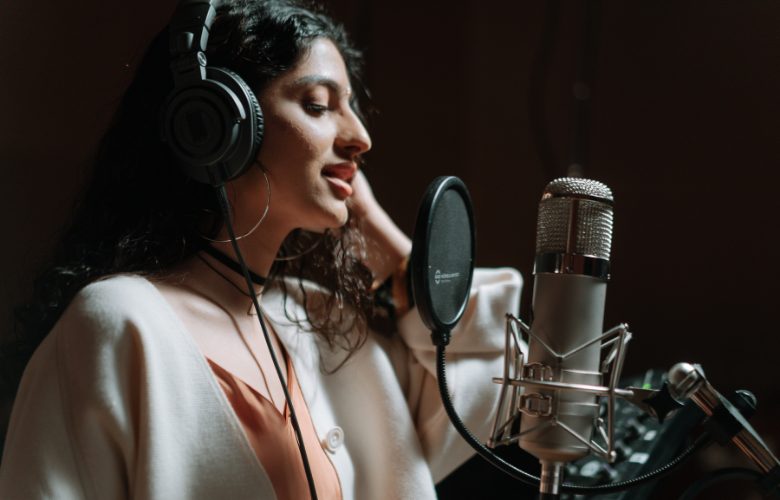
Banished. That’s where my kids would be when I recorded at home pre-pandemic. Not banished to their knowledge, just hanging with their grandparents for at least an entire day, at most overnight. The point is they would be gone, and I’d have sent our dog with them, too, if I’d had my way.
During the pandemic, I found myself itching to record and determined to avoid exposing vulnerable elders to a virus. Short of going into debt building a proper studio at home, I applied my knowledge and resources to develop these strategies:
Directional microphones are your friend. In an ideal recording situation, a large-diaphragm condenser microphone, like my Lauten 220, would be my preference for recording acoustic guitar and vocals. In my loud house, however, noise reduction was key. My kids could be shrieking away in the other room, but with my SM7B pointed away from them, I could sing my heart out with only minimal bleed. Plus, I could point my SM57 or Sennheiser e609 at my amp, again facing away from the children, to get some electric guitar underway.
Sound treatment is your friend. Believe me, I wish my home were properly sound treated – for so many reasons, not just recording purposes. In a pinch, it helps to hang quilts, order some shipping blankets, or hide out in a closet. It all works to cut down on noise. However, be sure to avoid cheap foam options that attenuate only higher frequencies doing little for the low end.
Record directly if you can. If you have a decent DI to connect your instrument to your interface, you won’t have to worry about home interference at all. You can always add effects later, and you may even come up with something innovative and fun with that dry signal. Many interfaces even allow for this without a DI.
Do many takes. While you have everything set up, run through the miked stuff a few times, keeping the same distance from the microphone when you sing or play for consistency’s sake. The little ones won’t scream at the same exact part each time you sing the song unless they’re especially cruel and deliberate about it. You can stitch together the best takes later.
Communicate. Let the kids know you’re going to be doing something special and need quiet for a short while. Talk about what they can be doing to entertain themselves in the meantime. Set boundaries accordingly beforehand and there should be fewer interruptions. Just be prepared to keep your promises if you make any (i.e. ice cream following the recording session, etc.)
It’s never going to be perfect, and of course, it requires flexibility, but it’s completely possible to record at home with your kids around. Breaks may be necessary and you may not get the best sound of your life, but what’s the alternative? Not doing it? Make those perfectly imperfect recordings at home. Lead by example and show the young ones in your life that there is always room for creativity so that they can learn to prioritize their own as they move beyond childhood. And if all else fails, scrap it and try again when they’re asleep.
The Groundbreaking Feminine Power of Rock Icon Stevie Nicks


The mission of SoundGirls.org is to inspire and empower the next generation of women in audio. Our mission is to create a supportive community for women in audio and music production, providing the tools, knowledge, and support to further their careers. SoundGirls.Org was formed in 2013 by veteran live sound engineers Karrie Keyes and Michelle Sabolchick Pettinato and operates under the Fiscal Sponsorship of The California Women’s Music Festival, a 501(c)3 non-profit organization. In 2012, Karrie and Michelle participated in the “Women of Professional Concert Sound” panel at the AES Conference in San Francisco. The panel was hosted by the Women’s Audio Mission (WAM) and moderated by WAM founder Terri Winston. Terri brought together five women working in live and broadcast audio. The groundbreaking panel (which also included Jeri Palumbo, Claudia Engelhart and Deanne Franklin), provided young women and men a glimpse into life on the road, tips and advice, and a Q & A with the panelists. More importantly though, was how incredibly powerful the experience was for the panelists. We had all been in the business for 20 years or more, yet most of us had never met before that day and within minutes we bonded like long-lost sisters. We were struck by how similar our experiences, work ethics, and passions were and wondered why our paths had never crossed and how our careers would have been different had we been there to support each other through the years. Each of us are strong on our own, but together we were even stronger and a powerful force. We were empowered. Each of us had been asked hundreds of times in our careers: Are there other women doing sound? How did you get into sound? How would a young woman go about getting into sound? Through creating SoundGirls.Org, we hope to establish a place for women working in professional audio to come for support and advice, to share our success and failures, our joys and frustrations, and for empowerment and inspiration.
Read Full Profile© 2021 TheatreArtLife. All rights reserved.

Thank you so much for reading, but you have now reached your free article limit for this month.
Our contributors are currently writing more articles for you to enjoy.
To keep reading, all you have to do is become a subscriber and then you can read unlimited articles anytime.
Your investment will help us continue to ignite connections across the globe in live entertainment and build this community for industry professionals.